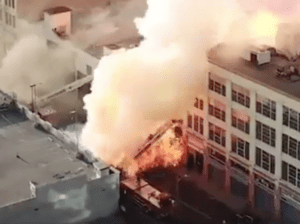Identifying Hazards in Buildings

Today’s modern world is faster and more complex than ever before, but one thing remains the same –, the level of safety which a building offers, is directly related to the hazard or hazards located within that structure. These hazards must be properly identified and evaluated to protect us from catastrophic events. Evaluations are done in many ways from the initial use and occupancy, acceptance testing, periodic inspections from regulatory agencies, life safety inspections, specific hazard evaluations, and general pre-planning of structures by public safety agencies.

Last week we saw a horrific explosion in a structure at 327 East Boyd Street located in Los Angeles, California. This incredible deflagration (explosion) injured 12 LAFD firefighters, causing catastrophic damage and is exactly the hazard we hope to protect and mitigate with proper hazard analysis and prevention inspection programs.
An LAFD Public Information Officer described the incident as “a significant explosion” in what has been identified as a wholesale supplier of butane hash oil or BHO. In 2018, the cannabis oil industry was estimated to be a $10.4 billion business in U.S. legal medical and recreational sales. Butane is a highly flammable, colorless gas. Volatile solvents like butane, ethanol, propane, and hexane are often used in the extraction process and have led to hundreds of fires and explosions around the country. As the demand for BHO increases nationwide, so do the facilities using volatile solvents in all sorts of extraction processes.
In the March-April edition of National Fire Sprinkler Magazine , Mark Hopkins, Former Vice President of Engineering at NFSA, discussed these facilities in his article “Sprinkler Protection in Changing Environments.” Mark spotlights the need to develop specific prescriptive requirements for these rapidly changing environments and some of the common hazards associated with them. The article highlights the need to be proactive with identification and evaluating the potential hazards in buildings.
The 2018 edition of NFPA 1 Fire Code, in the general requirements section, states that the basic goal of this code is to provide a reasonable level of safety, property protections, and public welfare from hazards created by fire, explosion, and other hazardous conditions.
4.1.1 Goals. The goals of this code shall be to provide a reasonable level of safety, property protections, and public welfare from hazards created by fire, explosion, and other hazardous conditions
The code also clearly places that responsibility of compliance with the owner, operator, or occupant.
10.2.1 The owner, operator or occupant shall be responsible for the compliance of this code.
It is the authority having jurisdiction’s (AHJ) responsibility to enforce the code. The fire code gives clear authority to the AHJ to require the owner, operator, or occupant to abate any condition deemed unsafe.
10.2.4 The owner, operator, or occupant of a building that is deemed unsafe by the AHJ shall abate, through corrective action approved by the AHJ, the condition causing the building to be unsafe either by repair, rehabilitation, demolition, or other corrective action approved by the AHJ
NFPA 1 created an entirely new chapter, dedicated just to regulating marijuana growing, processing, and extraction facilities. The use of highly flammable solvents like butane are noted in Section 38.6.2 “Liquefied Petroleum Gas (LPG) Extraction” and specifically require these facilities to meet all sections found in that chapter along with any other applicable provisions of the code.
38.1.2 The use, storage, transferring, and handling of hazardous materials shall comply with this chapter, and other applicable provisions of this code.
38.1.4 Where a material, is use, or associated process poses multiple hazards, all hazards shall be addressed in accordance with applicable requirements
This chapter includes, but is not limited to, the requirements for fire protection systems, fire alarms, permits, fumigation, signage, occupancy limitations, ventilation, pesticides, extraction rooms, electrical, combustible exhaust systems, and gas detection. It is also inclusive of the applicable requirements of any applicable building codes.
38.1.5 The occupancy of the buildings or portions of the buildings where the growing or processing of marijuana occurs shall be in accordance with chapter 6 and the applicable building codes.
The 2021 edition of NFPA 1 will bring even more changes to Chapter 38 by renaming the chapter from “Marijuana Growing, Processing, or Extraction Facilities” to “Cannabis Growing, Processing, or Extraction Facilities” to better reflect the more common nomenclature used in the industry. This edition will also better address the use of carbon dioxide and provide guidance on its use in enriching plant growth, while also addressing additional hazards within these multi hazard occupancies.
These types of facilities are just one example of the vast array of hazards encountered that must be inspected and properly protected with the appropriate fire protection programs. Although we must wait for the 327 East Boyd Street fire investigation to be completed in order to truly understand the circumstances leading to this catastrophic event, this should not detract us from continuing to identify hazards and enforcing all applicable codes and standards through proper inspection programs.
